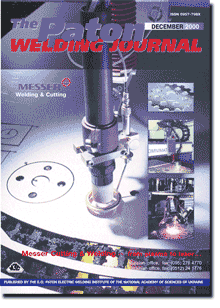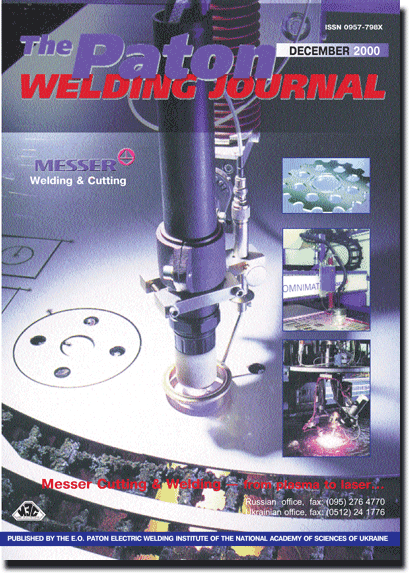

| PLASMA TECHNOLOGIES | |
| PLASMA TECHNOLOGIES AT THE TRANSITION OF THE CENTURIES. | 2 |
|
ESIBYAN E.M. AIR-PLASMA CUTTING: STATE-OF-THE-ART AND PROSPECTS | 4 |
| Analysis of the current status of air-plasma cutting, its technological capabilities and cost-effectiveness is given and the prospects for development of this method of processing metals and their alloys are shown. Thermal and electrophysical properties of air-plasma arc, various design solutions and schematics, used in development of plasmatrons and power sources are described. The technical characteristics of the currently available locally made and foreign air-plasma units are given. | |
|
SMIRNOV V.V., ROGOVOJ M.D. and POVSTYAN V.I. ACTIVITY OF THE RUSSIAN INSTITUTE OF WELDING IN THE FIELD OF PLASMA EQUIPMENT AND TECHNOLOGY (REVIEW) | 15 |
| Developments of the Russian Institute of Welding in the field of plasma treatment of materials: spraying, surfacing and welding, as well as air-plasma cutting and plasma recycling of wastes, are described. They include technologies for air-plasma cutting of ferrous metals and stainless steels up to 40 mm thick, aluminium and copper up to 50 and 20 mm thick, respectively, lines for automatic welding of super thin-walled (0.17-0.50 mm) small-diameter (4-8 mm) tubes and ecological plasma arc reactor which can be installed into any gas line. | |
|
VASILIEV K.V. FEATURES OF PLASMA ARC CUTTING IN NITROGEN-OXYGEN MIXTURES (REVIEW) | 18 |
| Published data on the influence of nitrogen and oxygen in the plasma on cutting speed have been analyzed. Influence of the composition of the plasma and cutting modes on the composition of the combustion products has been investigated. New concepts of the mechanism of iron burning in steel cutting in the nitrogen-oxygen plasma are substantiated. Development of a combined autogenous-plasma machine is described. | |
|
GVOZDETSKY V.S. and MAKARENKO N.A. PLASMA WELDING (REVIEW) | 24 |
| Plasma arc process sequences and design features of plasmatrons are considered. Plasma process advantages compared to other arc welding processes are described. Illustrations of technological capabilities of plasma welding and its effective application in rocket engineering, ship-building, power generation and other industries are given. The effectiveness of application of combined plasma processing with two arcs, a plasma arc and laser beam is noted. | |
|
PEREPLYOTCHIKOV E.F. PLASMA-POWDER SURFACING IN SHIP MACHINE BUILDING | 29 |
| The results of investigations of some properties and performance of Co-, Ni- and Fe-base alloys are given. Possibility of plasma surfacing of aluminium bronze parts with cobalt and nickel alloys is studied. The effectiveness of application of plasma-powder surfacing in ship machine building is demonstrated. P. 29 | |
|
SOM A.I. and KRIVTSUN I.V. LASER + PLASMA: SEARCH FOR NEW POSSIBILITIES IN SURFACING | 34 |
| Method of combination of a laser beam and plasma arc for realization of a combined process of a laser-plasma cladding is suggested. A prototype of a laser-arc plasmatron for a powder cladding was designed and manufactured. A detailed computer modelling of a combined discharge in the given plasmatron and experimental studies of its characteristics and technological capabilities of the mentioned process were made. It is shown that the combined use of a laser beam and plasma arб increases the speed, stability and reproducibility of results of cladding, and also efficiency of using these sources of heating. | |
|
BORISOV Yu.S., KRIVTSUN I.V., MUZHICHENKO A.F., LUGSCHEIDER E. and ERITT U. COMPUTER MODELLING OF THE PLASMA SPRAYING PROCESS | 40 |
| Mathematical models have been constructed and software has been developed for computer modelling of the turbulent plasma jets formed during plasma spraying and behaviour of the spray particles in such jets. Detailed computer modelling of the processes of plasma spraying of particles of nickel and aluminium oxide using argon and nitrogen as the plasma gas, and corresponding experimental studies of these processes have been conducted. The ISSO-1 device has been used to measure velocities and paths of the spray particles. The computer modelling results are in good agreement with the experimental data. | |
|
PETROV S.V., SAAKOV A.G., KOTLYAROV O.L. and YATSENKO V.P. MODELLING OF HEATING AND MOVEMENT OF PARTICLES IN ARC PLASMA AT SUPERCRITICAL PRESSURE GRADIENT | 51 |
| Results of calculation of the electric arc burning under conditions of a supercritical pressure gradient in a blocked nozzle and with dispersed particles injected in it are given. It is shown that a plasmatron based on this principle is an efficient means for heating and acceleration of the spraying powder. Molten particles which are not subjected to splitting in flight leave the arc plasma in such a plasmatron at a velocity of about 1000 m/s, which provides a substantial improvement in properties of the sprayed coatings. | |
|
BORISOV Yu.S. and KOLISNICHENKO O.V. INVESTIGATION OF AMPLITUDE-TIME CHARACTERISTICS OF THE CURRENT PULSE IN PLASMA-DETONATION TREATMENT OF ITEMS | 55 |
| The results of the work on creation and development of plasma-detonation technology based on the detonation wave transformation into a plasma pulse, are described. The current discharge between the electrode of the plasma generator and the part being processed provides an integrated action of the convective, beam and electronic types of heat transfer on the surface. Brief comparative analysis of plasma detonation treatment and laser technology of strengthening the item surface is given. | |
|
RUSEV G.M., OVSYANIKOV V.V., KISELYOV S.M. and GALYUK N.F. TECHNOLOGY OF RESTORATION AND STRENGTHENING OF SURFACES OF BODIES OF ROTATION AND FLAT SURFACES USING PLASMA SPRAYING | 60 |
| Technology of plasma arc spraying with a feeding of a current-carrying wire sprayed and mechanical treatment of each layer of the multilayer coating using a rotating metallic brush. Examples of its application are given. | |
|
BORISOV Yu.S., VOJNAROVICH S.G., BOBRIK V.G., DUBOK V.A. and ULIANCHICH N.V. MICROPLASMA SPRAYING OF BIOCERAMIC COATINGS | 62 |
| Peculiarities and characteristics of the method of microplasma spraying allowing a reduction of up to 5-15 % in powder losses in spraying on small objects are given. The process of production and properties of microplasma coatings of bioactive ceramics, i.e. hydroxyapatite (HA) are investigated. Phase and structural transformations occurring in the HA particles during their heating in a microplasma jet and conditions of formation of the coatings are studied. The feasibility of spraying HA coatings with a low degree of dissociation and amorphization is shown. | |
|
LATASH Yu.V., KOLEDA V.N., TORKHOV G.F., LIKHOBABA A.V., SERGEEV V.P. and GORBACHEV G.F. PRODUCING OF COMBINED COMPONENTS WITH PERMANENT JOINTS USING PLASMA ARC REMELTING OF CHARGE | 67 |
| Technology of producing combined components with permanent joints for the feeders of a basalt casting is developed. This technology makes it possible to use the wrought high-chromium alloys with higher operating characteristics. Plasma arc remelting of charge using a cold hearth is used for producing slab billets with a simultaneous melting-in of technological parts into it. The absence of welds and high quality of the remelted metal can increase the serviceability of the components. | |
|
LAKOMSKY V.I. PLASMA ARC TORCH WITH AN OXIDE CATHODE | 70 |
| The application of a powder oxide cathode instead of a rod tungsten cathode in metallurgical plasmatrons (arctrons) is considered. This simplifies design significantly and increases the efficiency factor of the heating process. The arc discharge of the arctron is characterized by a well-formed plasma "flame" of the cylindrical shape and rising volt-ampere characteristic. | |
|
KALASHNIKOV A.V. and KORZH V.N. MODIFICATION OF PVR-402UKhL4 INDUSTRIAL PLASMATRON FOR SPRAYING OF WEAR-RESISTANT COATINGS IN A GAS-AIR PLASMA | 75 |
| The feasibility of updating the series-produced air-plasma cutting plasmatrons for their application in plasma spraying of powdered materials is shown. Method of optimizing of geometric sizes of a channel of nozzle and anode to achieve optimum values of the material utilization factor is given. | |
| "PLASMATRON" COMPANY IS 10 YEARS OLD. | 78 |
|
CHULYUKOV F.G., MODIN Yu.P., DRYGANT V.I., VORONKOV Yu.N. and
MALCHENKO A.P. PORTABLE MEGNETOCOPYING HINGE-TYPE MACHINE "CONTUR-500" FOR PLASMA CUTTING OF SHEET ROLLED METAL | 79 |
| The hinge-type machine for plasma cutting of the sheet rolled stock using a magnetocopying method of forming the contour of the component being cut is described. This machine is equipped with a device for a working gap tracing that provides its stabilization with an accuracy of ‘ 0.2 mm at cutting speeds up to 2500 mm/min. A kit of tools and components is also developed for the modification of the series-produced machines of the "Ogonyok" type for a thermal cutting. | |
|
LITVIN R.G. MODERN RUSSIAN LOW-POWER EQUIPMENT FOR AIR-PLASMA CUTTING | 81 |
| Peculiarities of low-power equipment for air-plasma cutting, imported to Russia at the first half of the 1990s, are considered. Specialized equipment for the air-plasma cutting designed and manufactured now at the JSC "Spetselektromash" is described. | |
| ADVERTISING | 59 |
| INFORMATION | 88 |
(You are viewing the simplified file contents)
The cost of subscription/purchase order journals or individual articles
| Journal/Currency | Annual Set | 1 issue printed |
1 issue |
one article |
| TPWJ/USD | 384 $ | 32 $ | 26 $ | 13 $ |
| TPWJ/EUR | 348 € | 29 € | 24 € | 12 € |
| TPWJ/UAH | 7200 UAH | 600 UAH | 600 UAH | 280 UAH |
| AS/UAH | 1800 UAH | 300 UAH | 300 UAH | 150 UAH |
| AS/USD | 192 $ | 32 $ | 26 $ | 13 $ |
| AS/EUR | 180 € | 30 € | 25 € | 12 € |
| SEM/UAH | 1200 UAH | 300 UAH | 300 UAH | 150 UAH |
| SEM/USD | 128 $ | 32 $ | 26 $ | 13 $ |
| SEM/EUR | 120 € | 30 € | 25 € | 12 € |
| TDNK/UAH | 1200 UAH | 300 UAH | 300 UAH | 150 UAH |
| TDNK/USD | 128 $ | 32 $ | 26 $ | 13 $ |
| TDNK/EUR | 120 € | 30 € | 25 € | 15 € |
AS = «Automatic Welding» - 6 issues per year;
TPWJ = «PATON WELDING JOURNAL» - 12 issues per year;
SEM = «Electrometallurgy Today» - 4 issues per year;
TDNK = «Technical Diagnostics and Non-Destructive Testing» - 4 issues per year.


